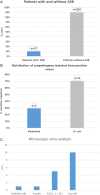Prevalence of undiagnosed asymptomatic bacteriuria and associated risk factors during pregnancy: a cross-sectional study at two tertiary centres in Cairo, Egypt
- PMID: 28325856
- PMCID: PMC5372043
- DOI: 10.1136/bmjopen-2016-013198
Prevalence of undiagnosed asymptomatic bacteriuria and associated risk factors during pregnancy: a cross-sectional study at two tertiary centres in Cairo, Egypt
Abstract
Background: The prevalence of asymptomatic bacteriuria (ASB) during pregnancy is poorly understood in Egypt-a country with a high birth rate.
Objectives: To determine the prevalence of ASB among pregnant women booking at El Hussein and Sayed Galal Hospitals in Al-Azhar University in Egypt; and to observe the relationship between ASB prevalence and risk factors such as socioeconomic level and personal hygiene.
Setting: Obstetrics and gynaecology clinics of 2 university hospitals in the capital of Egypt. Both hospitals are teaching and referral hospitals receiving referrals from across over the country. They operate specialist antenatal clinics 6 days per week.
Participants: A cross-sectional study combining the use of questionnaires and laboratory analysis was conducted in 171 pregnant women with no signs or symptoms of urinary tract infection (1 case was excluded). Samples of clean catch midstream urine were collected and cultured using quantitative urine culture and antibiotic sensitivity tests were performed.
Results: Of 171 pregnant women, 1 case was excluded; 17 cases (10%, 95% CI 5.93% to 15.53%) were positive for ASB. There was a statistically significant relation between the direction of washing genitals and sexual activity per week-and ASB. Escherichia coli was the most commonly isolated bacteria followed by Klebsiella. Nitrofurantoin showed 100% sensitivity, while 88% of the isolates were resistant to cephalexin.
Conclusions: The prevalence of ASB seen in pregnant women in 2 tertiary hospitals in Egypt was 10%. E. coli and Klebsiella are the common organisms isolated. The direction of washing genitals and sexual activity significantly influences the risk of ASB. Pregnant women should be screened early for ASB during pregnancy; appropriate treatment should be given for positive cases according to antibiotic sensitivity screening. Cephalexin is likely to be of limited use in this management.
Keywords: Asymptomatic Bacteriuria; Egypt; Urinary Tract Infection; Urine Culture.
Published by the BMJ Publishing Group Limited. For permission to use (where not already granted under a licence) please go to http://www.bmj.com/company/products-services/rights-and-licensing/.
Conflict of interest statement
Figures


References
-
- Parveen K, Momen A, Begum AA et al. . Prevalence of urinary tract infection during pregnancy. J Dhaka Natl Med Coll Hosp 2012;17:8–12.
-
- Ebidor UL, Tolulope A, Deborah O. Urinary tract infection amongst pregnant women in Amassoma, Southern Nigeria. Afr J Microbiol Res 2015;9:355–9. 10.5897/AJMR2014.7323 - DOI
MeSH terms
Substances
LinkOut - more resources
Full Text Sources
Other Literature Sources
Medical
